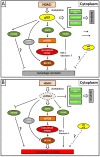p53-Mediated Molecular Control of Autophagy in Tumor Cells
- PMID: 29561758
- PMCID: PMC6022997
- DOI: 10.3390/biom8020014
p53-Mediated Molecular Control of Autophagy in Tumor Cells
Abstract
Autophagy is an indispensable mechanism of the eukaryotic cell, facilitating the removal and renewal of cellular components and thereby balancing the cell's energy consumption and homeostasis. Deregulation of autophagy is now regarded as one of the characteristic key features contributing to the development of tumors. In recent years, the suppression of autophagy in combination with chemotherapeutic treatment has been approached as a novel therapy in cancer treatment. However, depending on the type of cancer and context, interference with the autophagic machinery can either promote or disrupt tumorigenesis. Therefore, disclosure of the major signaling pathways that regulate autophagy and control tumorigenesis is crucial. To date, several tumor suppressor proteins and oncogenes have emerged as eminent regulators of autophagy whose depletion or mutation favor tumor formation. The mammalian cell "janitor" p53 belongs to one of these tumor suppressors that are most commonly mutated in human tumors. Experimental evidence over the last decade convincingly reports that p53 can act as either an activator or an inhibitor of autophagy depending on its subcellular localization and its mode of action. This finding gains particular significance as p53 deficiency or mutant variants of p53 that accumulate in the cytoplasm of tumor cells enable activation of autophagy. Accordingly, we recently identified p53 as a molecular hub that regulates autophagy and apoptosis in histone deacetylase inhibitor-treated uterine sarcoma cells. In light of this novel experimental evidence, in this review, we focus on p53 signaling as a mediator of the autophagic pathway in tumor cells.
Keywords: autophagy; histone deacetylase inhibitor; mTOR; p53; suberoylanilide hydroxamic acid; tumor.
Conflict of interest statement
The authors declare no conflict of interest.
Figures



References
Publication types
MeSH terms
Substances
LinkOut - more resources
Full Text Sources
Other Literature Sources
Research Materials
Miscellaneous

